Genre: Action/Strategy Developer: Sega Enterprises Publisher: Sega Enterprises Players: 1-2 Released: 1986 Platform: Master System
Do you remember MAD magazine? These days, it’s a specter of its former self, some kind of undead creation living off of its gigantic archives dating back to 1952. There used to be a time, however, when MAD was known as a comedic juggernaut. In the pre-Internet age, it was the go-to source for many parodies, satire, and biting commentary on politics and pop culture in easy-to-digest cartoon form. One its most famous features, starting back in 1961, was the wordless comic strip Spy vs. Spy. In it, two agents of espionage from unnamed opposing factions, one clad entirely in white and one completely in black, are locked in an eternal battle of one-upmanship. These men of mystery usually seem more interested in besting one another than in actually achieving their goal, trying to neutralize their opponents with various booby traps, hidden explosives, or schemes-within-schemes. Their antics were usually very slapstick. One typical comic strip would have the white spy (identified in other media outside the comics as “Heckel”) take a knife to a rope, believing that his opponent (“Jackel”) is using it to escape from a building, only to realize after the fact that said rope was holding up a 16-ton weight, which is now dropping straight on his own head.
The two spies and their iconic look – white-brimmed hats, beak-like noses, all-black eyes and matching wide tunic and pants – became so popular that they transcended the pages of MAD magazine and ventured into different media on their own, like Spy-vs-Spy branded merchandise, advertisement deals, and even their very own video games. Their first digital outing came in 1984 as a simultaneous two-player action game for the Commodore 64 and other 8-bit home computers of the day. This game proved immensely popular. By 1986, the Commodore would see two nearly identical sequels. That same year, the first game in the series would also receive console ports for the NES and the Sega Master System. For the latter, it was technically received twice, first as a Sega Card and later also in Cartridge form.
Spy vs. Spy sticks very close to its source material. Set in an embassy, both the white and the black spy need to search the place for five specific items: a passport, a key, cash, confidential documents, and a bag to put them all in. The items are hidden in six different rooms, behind coat racks, flower vases, desks, and other fixtures. Unless you have the bag, your spy can only carry one item at a time. So, if you find something, you should immediately try and stash it somewhere else – and ideally secure it with a trap – where you can easily find it again. A map can be accessed at any time in order to check which rooms may still contain an undiscovered item.
The game is always played in split-screen mode, with the white spy on top and the black spy in the bottom window. Both agents only have seven minutes to grab all the items and escape to the airport, while at the same time preventing their opponent from succeeding. To that end, they can attack their adversary directly when they’re in the same room by kicking or punching (buttons 1 and 2, respectively), or indirectly by setting up one of five different types of traps in the different rooms by using the “trapulater” menu. Doors can be booby trapped with buckets of electrified water or spring-loaded guns, while furniture can be secured with bombs or springs that act like catapults. These traps can be disarmed by finding and utilizing the corresponding countermeasures. As a last measure, you can also set a time bomb. There is no protection against this trap other than simply not being in the same room when it goes off. One needs to be careful though, as the spies can also fall victim to their own devices.
If a spy gets beaten up by his opponent or taken out by a trap, he’s not out of the picture yet; he will respawn after a while but loses some valuable seconds on the merciless timer. A round ends when one spy manages to secure all items in a bag and escape to the airport, or when the time runs out on both. In the case of the latter, the game tallies up the score and awards points for beating up the opponent, every item snatched, and every trap placed or successfully defended against. Points are deducted for every time your spy lost a fight, got taken out by a trap, or had to use the map screen. Needless to say, this leads to every round turning into a mad scramble of quickly combing the rooms, laying traps, trying to remember which room has already been searched or what door has been booby trapped, and so on.
The graphics and sounds are very spartan, which comes as little surprise considering the game was originally released on a Sega Card, which meant it could only have taken up to 32 Kilobytes of ROM. The only visually remarkable feature is that the six different rooms of the embassy can easily be distinguished by their background color. There are only two themes in the soundtrack, one being the title theme, the other the main track that plays throughout the game on a 25-second-loop. Both are very bleepy and will wear out their welcome eventually.
That’s all there is to this game: a series of short, multiplayer races against the clock through merely six different rooms. There are a few options you can set before the start of a match, such as whether you’d like to play against a second player or against a computer AI (the latter in three difficulty settings), the number of rounds you want to play (up to eight), and whether the exit to the airport should be visible even if all five items have not been located yet. Playing against the computer AI is not recommended. Even on the highest setting it’s not particularly bright (always making a beeline for the player if he’s in the room) and hardly offers any variety in tactics. If you’re able to beat it once, you’ll always be able to beat it.
Spy vs. Spy CAN be tons of fun – albeit only in two-player-mode, and even then, only in short bursts that won’t last longer than a couple of rounds in quick succession. Two-player matches immediately turn into a frantic scramble for the nearest room or item and watching your opponent waltz right into a booby trapped-door or an exploding picture frame is the epitome of schadenfreude. So playing it against a friend will certainly be worth a few giggles every once in a while, and if you only play it in short sessions, the game will take a while before it gets old. Still, even that well will run dry, especially if you play it for too long in a single sitting. Beyond a madcap vs. mode, Spy vs. Spy doesn’t offer any real substance. Although it’s a classic on the C64 and other home computers, it’s hard to recommend getting the game as a Master System release. The graphics and sound are mediocre, the gameplay is very limited, the length too short, and as a single-player-game, Spy vs. Spy is just a bore.
SCORE: 6 out of 10

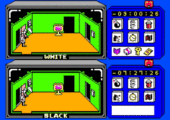
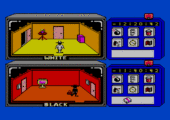
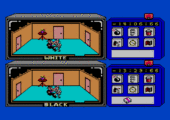
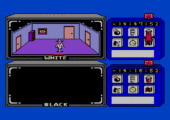
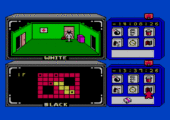
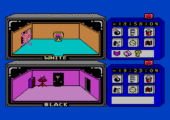
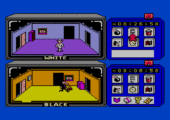
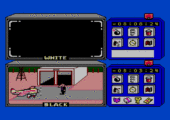

Recent Comments